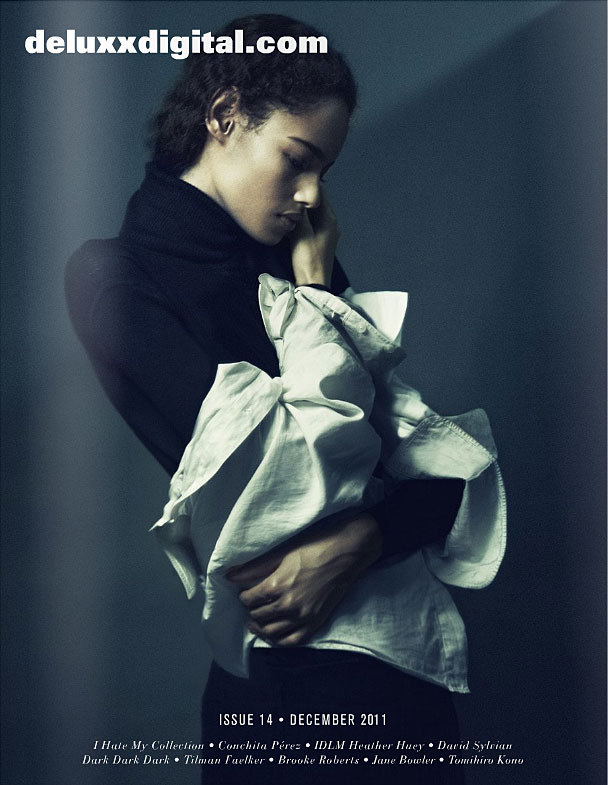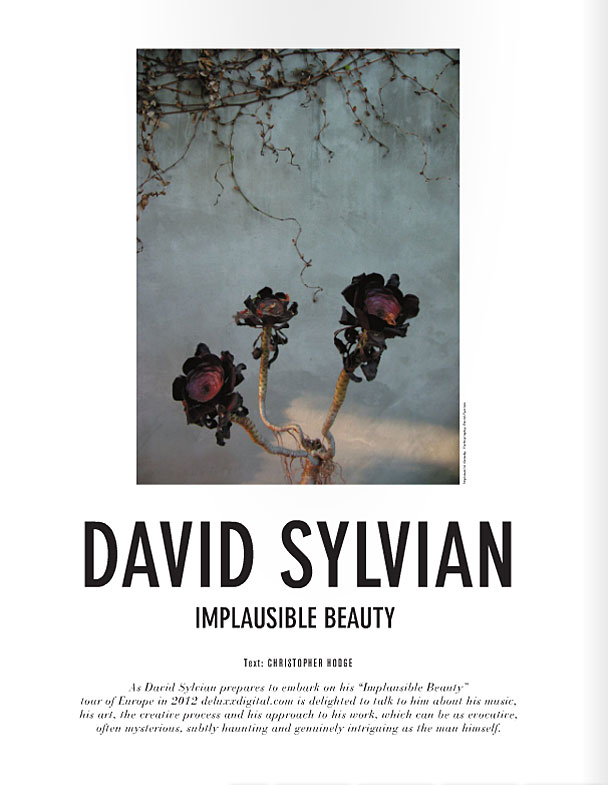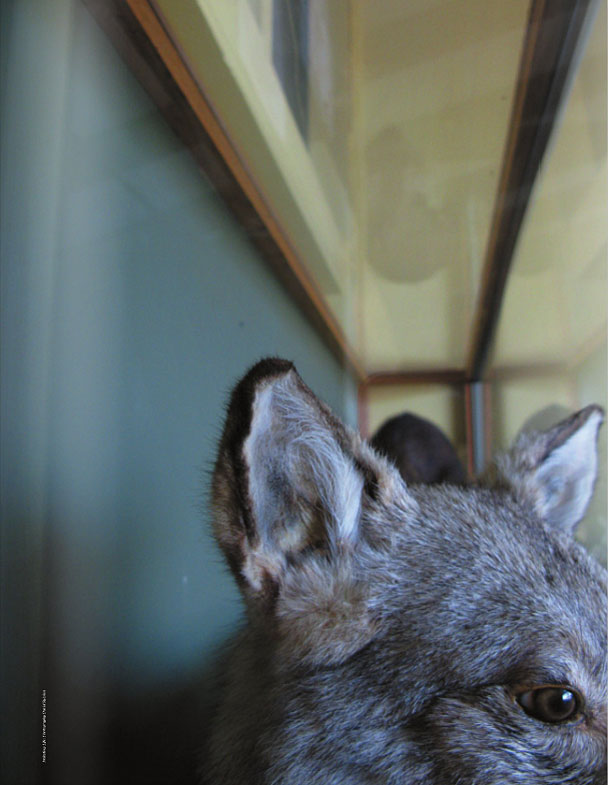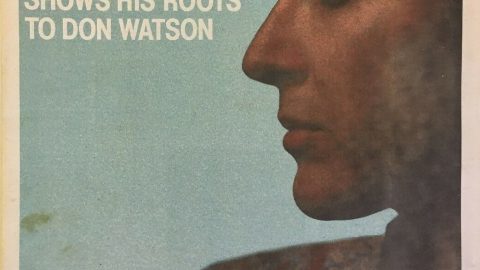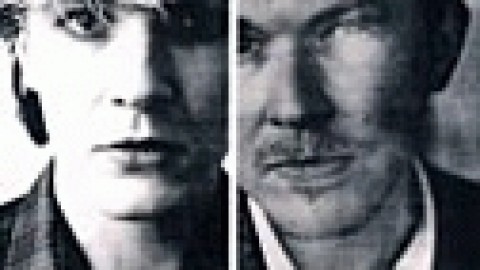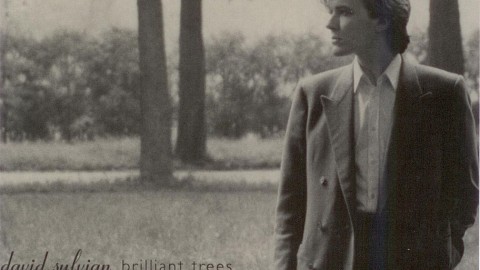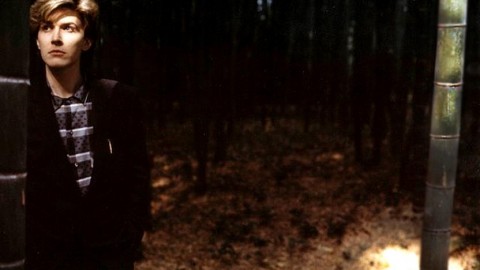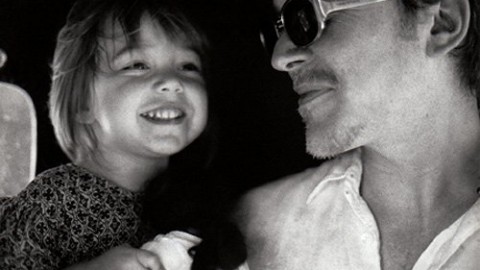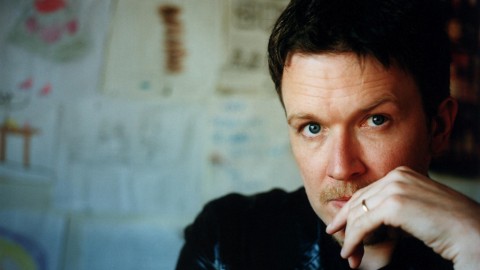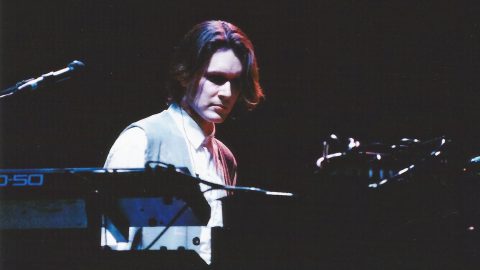
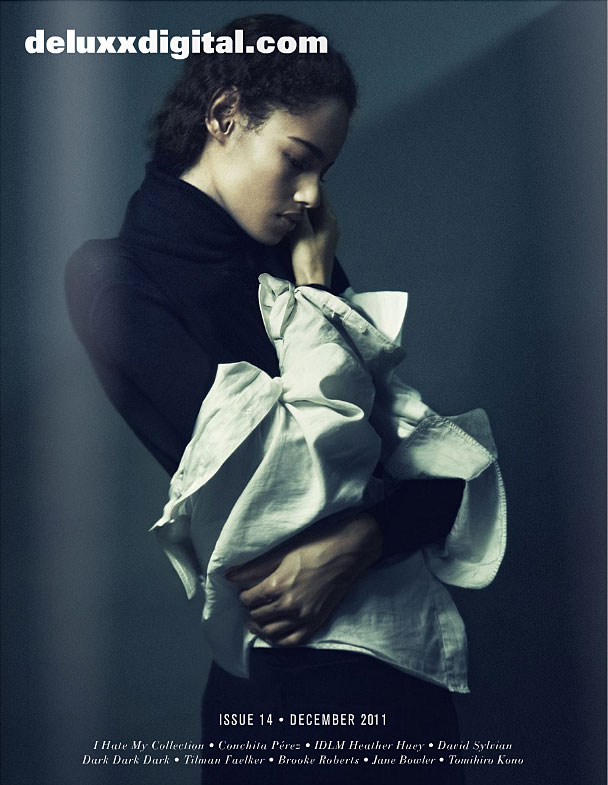

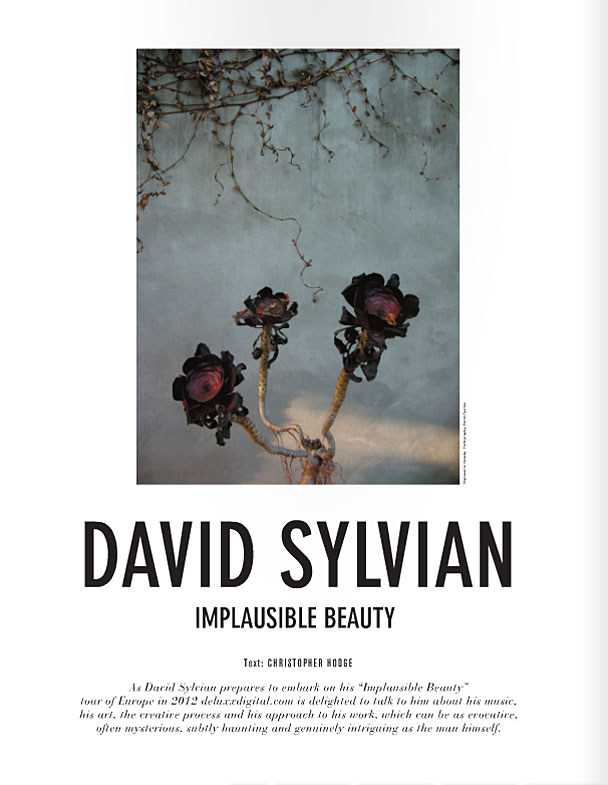

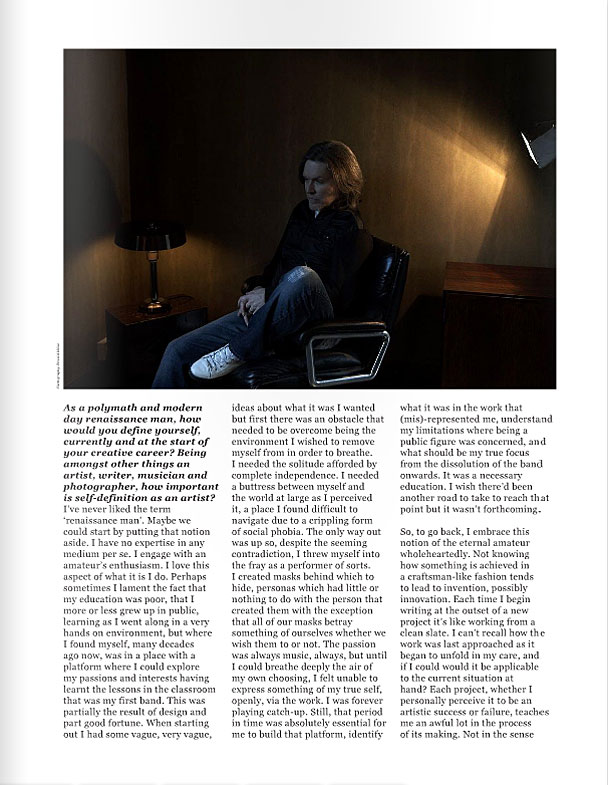

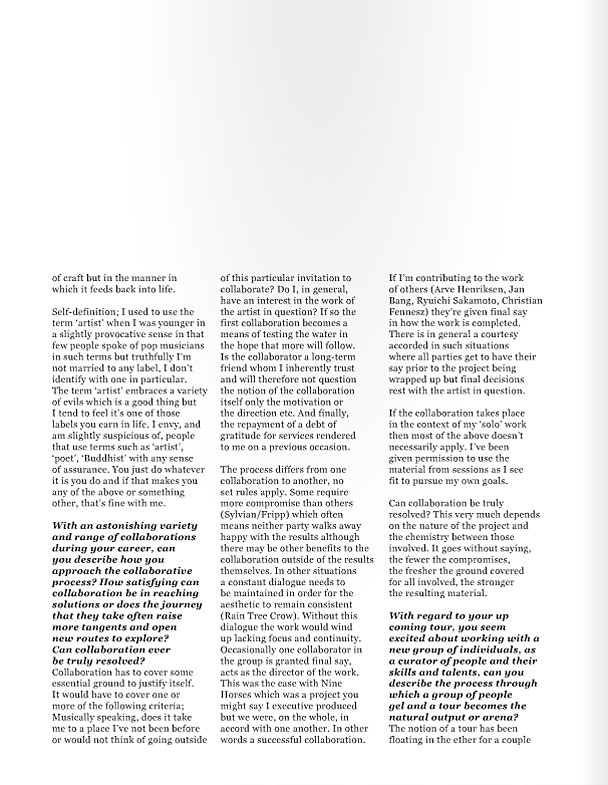

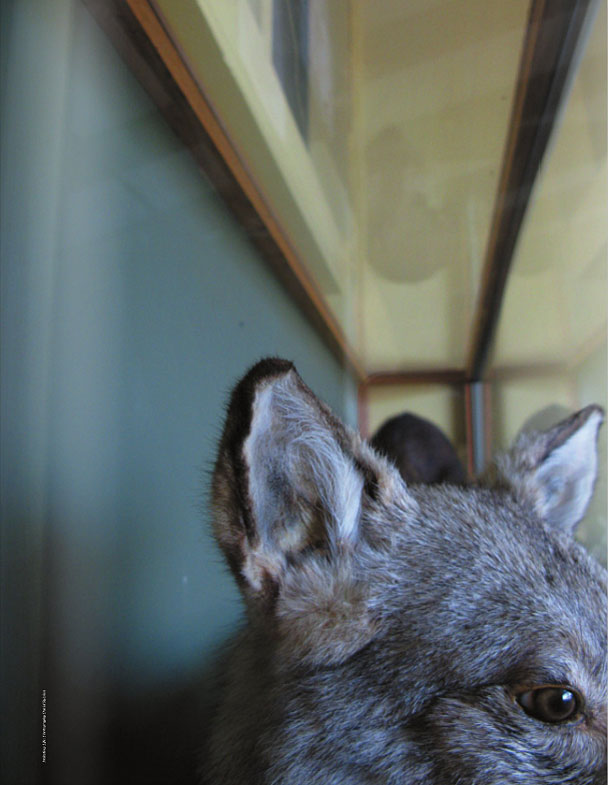

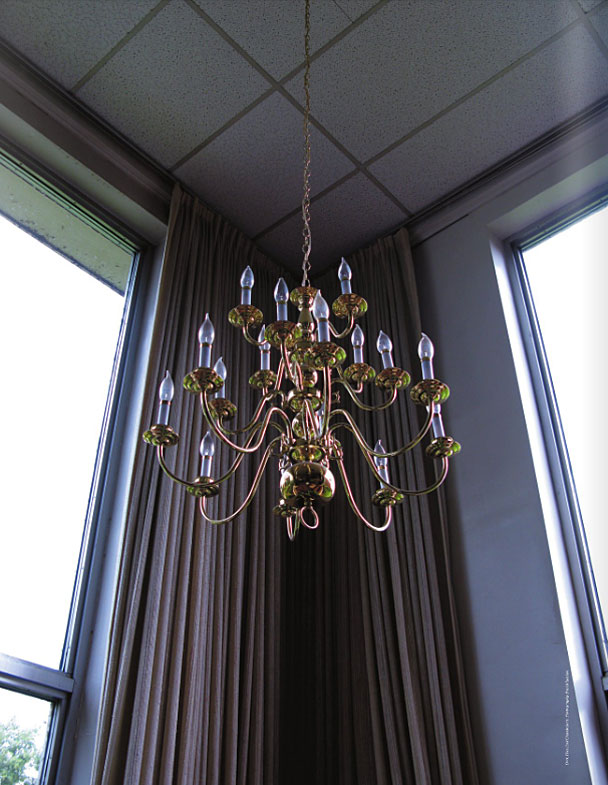

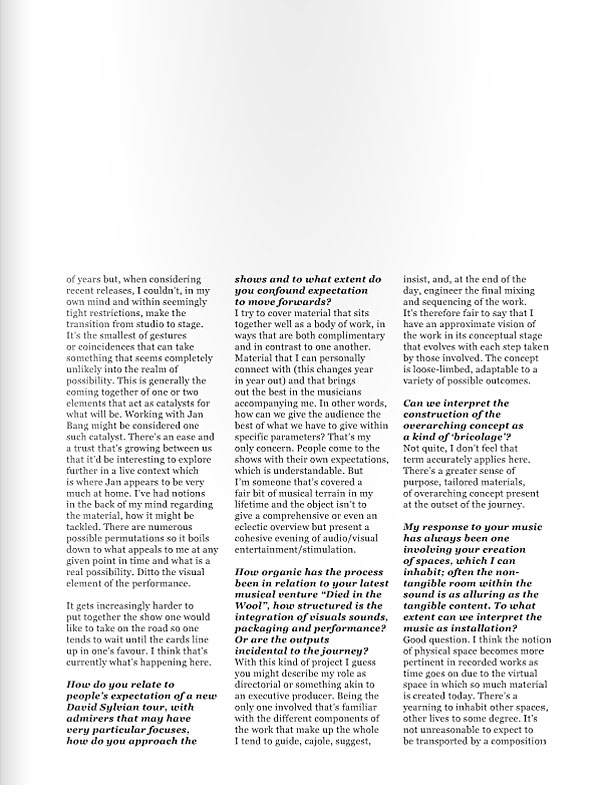

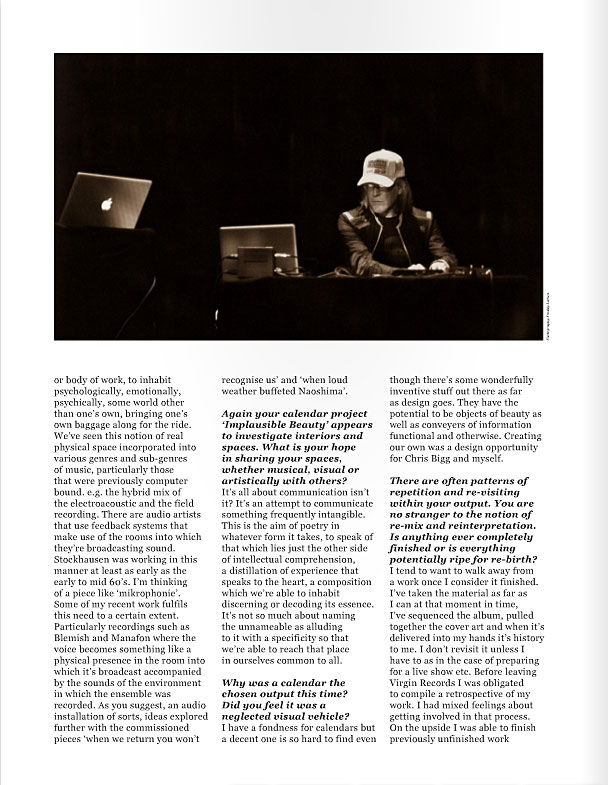

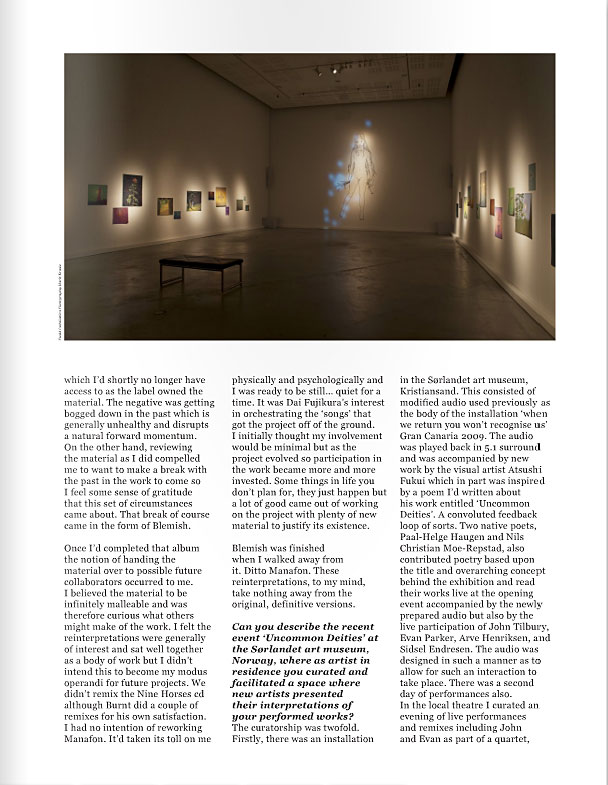

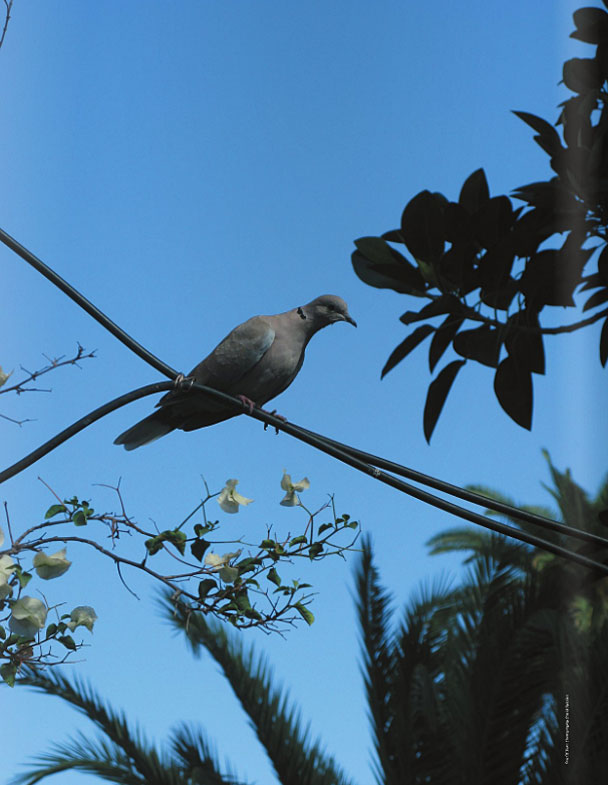
10 page interview by Christopher Hodge.
Interview in digital online magazine deluxxdigital.com
As David Sylvian. prepares to embark on his “Implausible Beauty” tour of Europe in 2012 deluxxdigital.com is delighted to talk to him about his music, his art, the creative process and his approach to his work, which can be as evocative, often mysterious, subtly haunting and genuinely intriguing as the man himself.
As a polymath and modern day renaissance man, how would you define yourself, currently and at the start of your creative career? Being amongst other things an artist, writer, musician and photographer, how important is self-definition as an artist?
I’ve never liked the term ‘renaissance man’. Maybe we could start by putting that notion aside. I have no expertise in any medium per se. I engage with an amateur’s enthusiasm. I love this aspect of what it is I do. Perhaps sometimes I lament the fact that my education was poor, that I more or less grew up in public, learning as I went along in a very hands on environment, but where I found myself, many decades ago now, was in a place with a platform where I could explore my passions and interests having learnt the lessons in the classroom that was my first band. This was partially the result of design and part good fortune. When starting out I had some vague, very vague, ideas about what it was I wanted but first there was an obstacle that needed to be overcome being the environment I wished to remove myself from in order to breathe.
I needed the solitude afforded by complete independence. I needed a buttress between myself and the world at large as I perceived it, a place I found difficult to navigate due to a crippling form of social phobia. The only way out was up so, despite the seeming contradiction, I threw myself into the fray as a performer of sorts.
I created masks behind which to hide, personas which had little or nothing to do with the person that created them with the exception that all of our masks betray something of ourselves whether we wish them to or not. The passion was always music, always, but until I could breathe deeply the air of my own choosing, I felt unable to express something of my true self, openly, via the work. I was forever playing catch-up. Still, that period in time was absolutely essential for me to build that platform, identify what it was in the work that (mis)-represented me, understand my limitations where being a public figure was concerned, and what should be my true focus from the dissolution of the band onwards. It was a necessary education. I wish there’d been another road to take to reach that point but it wasn’t forthcoming.
So, to go back, I embrace this notion of the eternal amateur wholeheartedly. Not knowing how something is achieved in a craftsman-like fashion tends to lead to invention, possibly innovation. Each time I begin writing at the outset of a new project it’s like working from a clean slate. I can’t recall how the work was last approached as it began to unfold in my care, and if I could would it be applicable to the current situation at hand? Each project, whether I personally perceive it to be an artistic success or failure, teaches me an awful lot in the process of its making. Not in the sense of craft but in the manner in which it feeds back into life.
Self-definition; I used to use the term ‘artist’ when I was younger in a slightly provocative sense in that few people spoke of pop musicians in such terms but truthfully I’m not married to any label, I don’t identify with one in particular.
The term ‘artist’ embraces a variety of evils which is a good thing but I tend to feel it’s one of those labels you earn in life. I envy, and am slightly suspicious of, people that use terms such as ‘artist’, ‘poet’, ‘Buddhist’ with any sense of assurance. You just do whatever it is you do and if that makes you any of the above or something other, that’s fine with me.
With an astonishing variety and range of collaborations during your career. can you describe how you approach the collaborative process? How satisfying can collaboration be in reaching solutions or does the journey that they take often raise more tangents and open new routes to explore?
Can collaboration ever be truly resolved?
Collaboration has to cover some essential ground to justify itself.
It would have to cover one or more of the following criteria; Musically speaking, does it take me to a place I’ve not been before or would not think of going outside of this particular invitation to collaborate? Do I, in general, have an interest in the work of the artist in question? If so the first collaboration becomes a means of testing the water in the hope that more will follow. Is the collaborator a long-term friend whom I inherently trust and will therefore not question the notion of the collaboration itself only the motivation or the direction etc. And finally, the repayment of a debt of gratitude for services rendered to me on a previous occasion.
The process differs from one collaboration to another, no set rules apply. Some require more compromise than others (Sylvian/Fripp) which often means neither party walks away happy with the results although there may be other benefits to the collaboration outside of the results themselves. In other situations a constant dialogue needs to be maintained in order for the aesthetic to remain consistent (Rain Tree Crow). Without this dialogue the work would wind up lacking focus and continuity. Occasionally one collaborator in the group is granted final say, acts as the director of the work. This was the case with Nine Horses which was a project you might say I executive produced but we were, on the whole, in accord with one another. In other words a successful collaboration.
If I’m contributing to the work of others (Arve Henriksen, Jan Bang, Ryuichi Sakamoto, Christian Fennesz) they’re given final say in how the work is completed. There is in general a courtesy accorded in such situations where all parties get to have their say prior to the project being wrapped up but final decisions rest with the artist in question.
If the collaboration takes place in the context of my ‘solo’ work then most of the above doesn’t necessarily apply. I’ve been given permission to use the material from sessions as I see fit to pursue my own goals.
Can collaboration be truly resolved? This very much depends on the nature of the project and the chemistry between those involved. It goes without saying, the fewer the compromises, the fresher the ground covered for all involved, the stronger the resulting material.
Q:With regard to your up coming tour, you seem excited about working with a new group of individuals, as a curator of people and their skills and talents, can you describe the process through which a group of people gel and a tour becomes the natural output or arena?
A:The notion of a tour has been floating in the ether for a couple of years but, when considering recent releases, I couldn’t, in my own mind and within seemingly tight restrictions, make the transition from studio to stage. It’s the smallest of gestures or coincidences that can take something that seems completely unlikely into the realm of possibility. This is generally the coming together of one or two elements that act as catalysts for what will be. Working with Jan Bang might be considered one such catalyst. There’s an ease and a trust that’s growing between us that it’d be interesting to explore further in a live context which is where Jan appears to be very much at home. I’ve had notions in the back of my mind regarding the material, how it might be tackled. There are numerous possible permutations so it boils down to what appeals to me at any given point in time and what is a real possibility. Ditto the visual element of the performance.
It gets increasingly harder to put together the show one would like to take on the road so one tends to wait until the cards line up in one’s favour. I think that’s currently what’s happening here.
How do you relate to people’s expectation of a new David Sylvian tour, with admirers that may have very particular focuses, how do you approach the shows and to what extent do you confound expectation to moveforwards?
I try to cover material that sits together well as a body of work, in ways that are both complimentary and in contrast to one another. Material that I can personally connect with (this changes year in year out) and that brings out the best in the musicians accompanying me. In other words, how can we give the audience the best of what we have to give within specific parameters? That’s my only concern. People come to the shows with their own expectations, which is understandable. But I’m someone that’s covered a fair bit of musical terrain in my lifetime and the object isn’t to give a comprehensive or even an eclectic overview but present a cohesive evening of audio/visual entertainment/stimulation.
How organic has the process been in relation to your latest musical venture “Died in the Wool”, how structured is the integration of visuals sounds, packaging and performance? Or are the outputs incidental to the journey?
With this kind of project I guess you might describe my role as directorial or something akin to an executive producer. Being the only one involved that’s familiar with the different components of the work that make up the whole I tend to guide, cajole, suggest, insist, and, at the end of the day, engineer the final mixing and sequencing of the work. It’s therefore fair to say that I have an approximate vision of the work in its conceptual stage that evolves with each step taken by those involved. The concept is loose-limbed, adaptable to a variety of possible outcomes.
Can we interpret the construction of the overarching concept as a kind of ‘bricolage’?
Not quite, I don’t feel that term accurately applies here. There’s a greater sense of purpose, tailored materials, of overarching concept present at the outset of the journey.
My response to your music has always been one involving your creation of spaces, which I can inhabit; often the nontangible room within the sound is as alluring as the tangible content. To what extent can we interpret the music as installation?
Good question. I think the notion of physical space becomes more pertinent in recorded works as time goes on due to the virtual space in which so much material is created today. There’s a yearning to inhabit other spaces, other lives to some degree. It’s not unreasonable to expect to be transported by a composition or body of work, to inhabit psychologically, emotionally, psychically, some world other than one’s own, bringing one’s own baggage along for the ride. We’ve seen this notion of real physical space incorporated into various genres and sub-genres of music, particularly those that were previously computer bound. e.g. the hybrid mix of the electroacoustic and the field recording. There are audio artists that use feedback systems that make use of the rooms into which they’re broadcasting sound. Stockhausen was working in this manner at least as early as the early to mid 60’S. I’m thinking of a piece like ‘mikrophonie’.
Some of my recent work fulfils this need to a certain extent. Particularly recordings such as Blemish and Manafon where the voice becomes something like a physical presence in the room into which it’s broadcast accompanied by the sounds of the environment in which the ensemble was recorded. AB you suggest, an audio installation of sorts, ideas explored further with the commissioned pieces ‘when we return you won’t recognise us’ and ‘when loud weather buffeted Naoshima’.
Again your calendar project ‘Implausible Beauty’ appears to investigate interiors and spaces. What is your hope in sharing your spaces, whether musical, visual or artistically with others?
It’s all about communication isn’t it? It’s an attempt to communicate something frequently intangible. This is the aim of poetry in whatever form it takes, to speak of that which lies just the other side of intellectual comprehension, a distillation of experience that speaks to the heart, a composition which we’re able to inhabit discerning or decoding its essence. It’s not so much about naming the unnameable as alluding to it with a specificity so that we’re able to reach that place in ourselves common to all.
Why was a calendar the chosen output this time? Did you feel it was a neglected visual vehicle?
I have a fondness for calendars but a decent one is so hard to find even though there’s some wonderfully inventive stuff out there as far as design goes. They have the potential to be objects of beauty as well as conveyers of information functional and otherwise. Creating our own was a design opportunity for Chris Bigg and myself.
There are often patterns of repetition and re-visiting within your output. You are no stranger to the notion of re-mix and reinterpretation. Is anything ever completely finished or is everything potentially ripe for re-birth?
I tend to want to walk away from a work once I consider it finished. I’ve taken the material as far as I can at that moment in time, I’ve sequenced the album, pulled together the cover art and when it’s delivered into my hands it’s history to me. I don’t revisit it unless I have to as in the case of preparing for a live show etc. Before leaving Virgin Records I was obligated to compile a retrospective of my work. I had mixed feelings about getting involved in that process. On the upside I was able to finish previously unfinished work which I’d shortly no longer have access to as the label owned the material. The negative was getting bogged down in the past which is generally unhealthy and disrupts a natural forward momentum.
On the other hand, reviewing the material as I did compelled me to want to make a break with the past in the work to come so I feel some sense of gratitude that this set of circumstances came about. That break of course came in the form of Blemish.
Once I’d completed that album the notion of handing the material over to possible future collaborators occurred to me.
I believed the material to be infinitely malleable and was therefore curious what others might make of the work. I felt the reinterpretations were generally of interest and sat well together as a body of work but I didn’t intend this to become my modus operandi for future projects. We didn’t remix the Nine Horses cd although Burnt did a couple of remixes for his own satisfaction. I had no intention of reworking Manafon. It’d taken its toll on me physically and psychologically and I was ready to be still … quiet for a time. It was Dai Fujikura’s interest in orchestrating the ‘songs’ that got the project off of the ground.
I initially thought my involvement would be minimal but as the project evolved so participation in the work became more and more invested. Some things in life you don’t plan for, they just happen but a lot of good came out of working on the project with plenty of new material to justify its existence.
Blemish was finished when I walked away from it. Ditto Manafon. These reinterpretations, to my mind, take nothing away from the original, definitive versions.
Can you describe the recent event ‘Uncommon Deities’ at the Serlandet art museum, Norway, where as artist in residence you curated and facilitated a space where new artists presented their interpretations of your performed works?
The curatorship was twofold. Firstly, there was an installation in the Sarlandet art museum, Kristiansand. This consisted of modified audio used previously as the body of the installation ‘when we return you won’t recognise us’ Gran Canaria 2009. The audio was played back in 5.1 surround and was accompanied by new work by the visual artist Atsushi Fukui which in part was inspired by a poem I’d written about his work entitled ‘Uncommon Deities’. A convoluted feedback loop of sorts. Two native poets, Paal-Helge Haugen and Nils Christian Moe- Repstad, also contributed poetry based upon the title and overarching concept behind the exhibition and read their works live at the opening event accompanied by the newly prepared audio but also by the live participation of John Tilbury, Evan Parker, Arve Henriksen, and Sidsel Endresen. The audio was designed in such a manner as to allow for such an interaction to take place. There was a second day of performances also.
In the local theatre I curated an evening of live performances and remixes including John and Evan as part of a quartet, Toshi Nakamura and Tetuzi Akiyama with the ensemble Koboku Senju and newly commissioned work by Dai Fujikura etc. The evening ended with the first live performance of ‘Plight and Premonition’, two pieces I’d recorded with Holger Czukay back in the late 1980’S. Participating musicians included the founders of the Punkt festival and recent collaborators, Jan Bang and Erik Honore, Eivind Aarset, Arve Henriksen, Philip Jeck and John Tilbury.
Your work across all medias is very layered and sensual; you often seem to make use of the contrasts between technology and artisanal processes, exploring the dichotomy betuseen electronic and more traditional instrumentation and sound making. How important is the blend of these worlds?
The recipe varies from one work to another. A balance is struck in correlation to what is it one’s attempting to address. This is usually a ‘decision’ that’s arrived at intuitively whilst the work is in a period of gestation. During that time, more often than not, it becomes clear what will or will not be called upon to help bring the material to life. There’s an intelligence at work that appears to understand the body of work’s diverse range and/or its limitations, which will help to define it, which will form its vocabulary if you will, each element, each syllable, inseparable from the next. As a composer you learn to listen to this voice, abide by it.
How does your music and image creation speak to you in terms of gender? Do your outputs have different: voices or genders? Can music transcend traditional distinctions?
I’ve been considering this question of late as I’ve recently spent time with friends that move between the boundaries of gender with tremendous fluidity.
Their masculine and feminine selves seemingly cohabit without conflict. If I’m conflicted that discord tends to sit primarily on the masculine side of my nature rather than the feminine, which is a part of myself I’ve more or less always felt comfortable inhabiting. In the world I was brought up in masculinity represented itself as something harsh, violent, aggressive, fearful, an un-nuanced, wilfully unconscious state of being. In the same context the feminine was the inverse of this so I gravitated towards those qualities that tend to be ascribed to it remaining fully aware of my male identity and its attributes. Irrespective of these considerations there’s no denying the source of the material is a white male, it couldn’t be otherwise. Occasionally I’ll consciously switch gender in song, sometimes playfully, other times less so. Ultimately it’s possible to transcend such distinctions though especially if the issue of gender doesn’t sit at the base of one’s own identity. We are after all, so much more than gender, race etc. We can deal with these issues directly if we feel they need to be dealt with or we can dig deeper and speak from a place where, with caveats firmly in place, we rise above such limitations of self or absorb them into our overriding sense of ourselves. If one was to hold a belief in the possibility of reincarnation how could one look at a man or a woman, or one ethnicity over another, and make any kind of judgement? We are the ‘other’. That’s one reason why I find the concept of reincarnation a healthy one to entertain whether firmly believed in or not. I guess it comes down to the notion that I am not one but many and we are not many but one. I’m only too aware of how flippant and trite that can sound when our experiences are so immensely diverse and there’s so much injustice and inequality in the world but I believe it to be the case nonetheless. It’s a subject for a longer conversation perhaps than we have time for here. .
You can engage with ‘being’ on so many levels from the self that’s identified with gender, race, occupation and so on, through to the purely sensory, emotional, intellectual etc., as far as one feels one has a right to travel without disrespect or disregard for the individual experiences of another. On the contrary, for the further one travels the slighter the boundaries between you and I, us and them become, and the greater this awareness the heavier the sense of personal responsibility as part of the larger social enterprise but, simultaneously and seemingly contradictorily, the more unattached one also becomes. In the current climate we may feel corrupted, broken and burned. As I’ve said before, we may need to embrace the spirit of revolution all over again. It would be truly something if we could rebuild upon the more stable foundations of our shared humanity.

